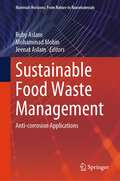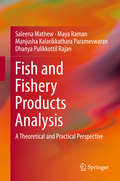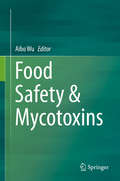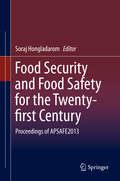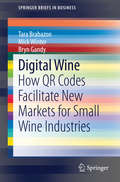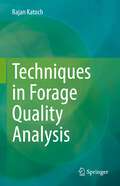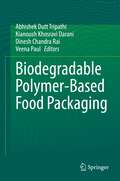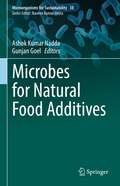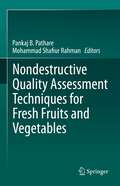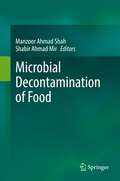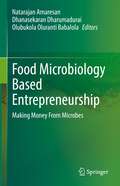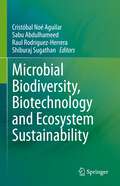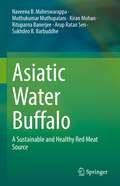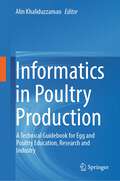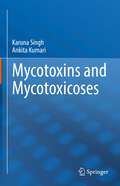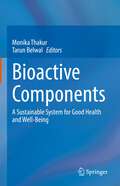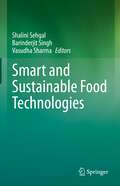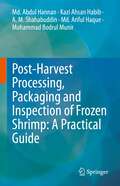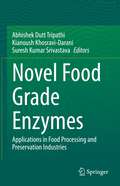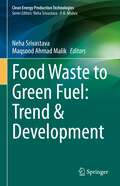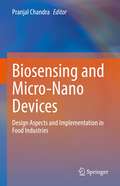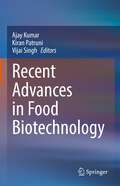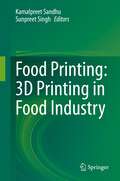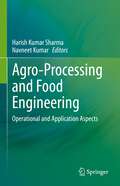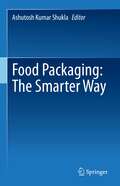- Table View
- List View
Sustainable Food Waste Management: Anti-corrosion Applications (Materials Horizons: From Nature to Nanomaterials)
by Ruby Aslam Mohammad Mobin Jeenat AslamThis book highlights established research and technology on corrosion inhibitors and bio-waste management. It further discusses emerging aspects of utilizing food waste in the field of corrosion inhibition. The topics covered include overview on bio-waste and their management, different types of food waste (i.e., agricultural, vegetable and fruit/fruit juice, plant waste, slaughterhouse trash), and their application as corrosion inhibitors and mitigation of corrosion. It also discusses economic aspects and commercialization of food waste as corrosion inhibitors. The book is a valuable reference for beginners, researchers, and professionals working in the areas of sustainability, food waste management, and material science.
Fish and Fishery Products Analysis: A Theoretical and Practical Perspective
by Saleena Mathew Maya Raman Manjusha Kalarikkathara Parameswaran Dhanya Pulikkottil RajanThis novel and informative book discusses the various aspects of seafood quality. The book is divided into 7 broad sections, each tackling a different aspect. The first section covers the general aspects relevant to the nutritional quality of the fish and the various extraction protocols for macro-/ micro-nutrients. The second section provides insights into handling and the principles of thermal and non-thermal processing techniques for commercially important fishery products. The quality standards and safety concerns in the seafood industry and consumption are discussed in this section. The freshness indices of the processed products including biochemical, microbiological and toxicological characteristics are also included. The third section discusses the physico-chemical characteristics and quality parameters of potable water/ ice. The fourth section includes the quality assessment of various toxicants related to seafood products. The fifth section deals with the specific aspects such as principle, instrument and procedures of conventional and novel analytical instruments relevant to the seafood industry. The sixth section deals with the seafood waste management including solid and liquid seafood wastes. Presently, there is a great awareness regarding environmental sustainable processing/ preservation techniques. The final chapter discusses the bioactive compounds from under-utilized marine sources showing pharmaceutical/ nutraceutical applications.
Food Safety & Mycotoxins
by Aibo WuMycotoxins are increasingly attracting attention at thegovernmental, public and academic level worldwide, due to more frequent and serious contaminations of food and feedstuffs, which pose a serious threat to human health and animal production. This book reviews the latest research on mycotoxins that directly concern food safety, and especially focuses on detection technologies, risk assessment and control strategiescurrently being used in China. Gathering contributions from over 20 respected researchers, the book will benefit graduatestudents, researchers and management groups from various disciplines, including food science and technology, analytical chemistry, plant pathology, public health, etc.
Food Security and Food Safety for the Twenty-first Century
by Soraj HongladaromThis book is a collection of selected papers that were presented at the First International Conference of the Asia-Pacific Society for Agricultural and Food Ethics (APSAFE 2013), which was held at Chulalongkorn University from November 28 - 30, 2013. The papers are interdisciplinary, containing insights into food security and food ethics from a variety of perspectives, including, but not limited to, philosophy, sociology, law, sociology, economics, as well as the natural sciences. The theme of the conference was to consider the interplay and balance between food security and food ethics as the world approaches the middle part of the twenty-first century.
Digital Wine
by Tara Brabazon Mick Winter Bryn GandyThis book explores the way in which QR codes (Quick Response codes) can help the wine industry facilitate distribution and more effectively market and sell their product. It examines the interventions, invention and opportunities brought about by QR codes for the wine industry. It also investigates how QR codes can help enable regional development as well as information and knowledge about winemakers and regions. The book begins with an introduction to QR codes. It explains how to use them as well as shows how QR codes combine analogue and online promotion and information dissemination. Next, the book explores strategies and examples from the creative industries, small nation theory and emerging wine industries. It then goes on to examine how to integrate QR codes with wine media, including marketing the bottle and using QR codes to build new wine regions. The book concludes with a case study of how Aotearoa/New Zealand wine producers deploy QR codes. QR codes can store and digitally present, a range of helpful data, including URL links, geo-coordinates and text and can be scanned by smart phones, making them a useful marketing and business tool. Presenting detail research on how QR codes can enhance the relationship between producers and consumers as well as aid regional development in the wine industry, this book will be of interest to academics focusing on Wine Studies, small and medium sized enterprises (SMEs) and practitioners and researchers from the creative industries sector. In addition, while this book focuses on the wine industry, the information that it presents about QR codes is relevant and applicable for an array of industries that require a tether between analogue and digital, physical and virtual, especially food and primary production.
Techniques in Forage Quality Analysis
by Rajan KatochThe book covers different techniques and methodologies involved in the nutritional quality analysis of forages. It also discusses the nutritional quality, anti-nutritional components, factors affecting forage quality, feed processing and conservation. Different techniques and methodologies have been presented in a simplified manner. The book has been divided in separate chapters and each chapter discusses different aspect of forage quality. Further, the book also covers the topics on conservation and processing of forages and management techniques for improving the forage nutritional quality. This book is an essential source of information for research scholars, post-graduate students and scientists working on forage quality estimation and also in livestock and dairy industries.
Biodegradable Polymer-Based Food Packaging
by Abhishek Dutt Tripathi Kianoush Khosravi Darani Dinesh Chandra Rai Veena PaulThis book covers different aspects of biodegradable packaging, such as their sourcing and application in food industries. The book focuses on the production and characterization of biodegradable food packaging derived from plant, animal and microbial sources. Chapters highlight the nano-technological interventions in biodegradable food packaging and the less studied microbial biopolymer-based biodegradable food packaging makes it distinct from other related books. It includes the latest research and development in the areas of food processing, food packaging, material science and polymeric science. It also discusses the standards and regulatory guidelines about the biodegradability testing of these polymers.This book is meant for researchers in food science, food packaging, bioprocess technology, polymer science and biochemical engineering. It is also beneficial for faculty members and students of food microbiology, food technology, dairy technology. The book is also meant for small entrepreneurs and farmers who are interested in bio-plastic usage for food packaging.
Microbes for Natural Food Additives (Microorganisms for Sustainability #38)
by Ashok Kumar Nadda Gunjan GoelThis book provides all the aspects of microbes for food additives, and a detailed description of their different categories. The chapters provide a step-by-step overview of microbial food additives as enzymes, antioxidants, stabilizers, emulsifiers, organic acids, colorants, sweeteners, flavoring compounds that have been used commercially by industrialists. In addition, an emphasis on the use of microbes as therapeutic agents such as probiotics and enzymes have also been given in the respective chapters. Furthermore, the book also comprises the detailed description of legislation and policies for the use of microbial additives at large scale in different food industries. Therefore, this book provides a comprehensive, state of art updated literature which can be used by the food scientists, nutritionists, microbiologists and a health-conscious layman to check the food additive list on a product for a nutritious and safer food.
Nondestructive Quality Assessment Techniques for Fresh Fruits and Vegetables
by Pankaj B. Pathare Mohammad Shafiur RahmanThis book describes the various techniques for nondestructive quality assessment of fruits and vegetables. It covers the methods, measurements, operation principles, procedures, data analysis, and applications for implementing these techniques.The book presents the details of nondestructive approaches focusing on the present-day trends and existing future opportunities in the fresh food supply chain. First, it overviews different nondestructive techniques in food quality detection. Then it presents nondestructive methods: monochrome computer vision, imaging techniques, biospeckle laser technique, Fourier Transform Infrared (FTIR) Spectroscopy, hyperspectral imaging, Raman spectroscopy, near infrared (NIR) spectroscopy, X-ray computed tomography, ultrasound, acoustic emission, chemometrics, electronic nose and tongue. Selected applications of each method are also introduced. As a result, readers gain a better understanding of how to use nondestructive methods and technologies to detect the quality of fresh fruits and vegetables.With a wide range of interesting topics, the book will benefit readers including postharvest & food scientists/technologists, industry personnel and researchers involved in fresh produce quality detection. The book can also serve as a readily accessible reference material for postgraduate students.
Microbial Decontamination of Food
by Manzoor Ahmad Shah Shabir Ahmad MirFood is contaminated in the production chain and is the point of concern among the consumers and industries. There is also a considerable increase in foodborne outbreaks, which possess the challenge to industry associated with the production of processed food. Various strategies are used to prevent the contamination during postharvest stage, storage and distribution. Different methods are exploited for degrading or eliminating the microbial contamination from food commodities. The conventional techniques used for decontamination demanded a considerable requirement for novel technologies, which are efficient, environmental friendly, and cost-effective. Novel technologies efficiently remove the contamination without adversely affecting the nutritional properties and sensory characteristics of food material. There is a lack of scientific information on the microbial decontamination of different food commodities such as fruits, vegetables, cereals, sprouts, microgreens, meat, poultry, milk, nut, spices etc. under one umbrella. The application of conventional and novel technologies for improving the food safety of individual food commodities will be addresses in this book. Written by several experts in the field, this book is a valuable source for students, scientists, and professionals in food science, food microbiology, food technology, food processing, and other allied sciences.
Food Microbiology Based Entrepreneurship: Making Money From Microbes
by Natarajan Amaresan Dhanasekaran Dharumadurai Olubukola Oluranti BabalolaThis book is first part of the 3 volume set focusing on basic and advanced methods for using microbiology as an entrepreneurial venture. This book deals with the concept of entrepreneurship skills for production, cost-benefit analysis and marketing of button, oyster, milky mushroom, Ganoderma sp, Single cell protein, Breads, Cheese, Yoghurt, Wine, Beer, Probiotics, Prebiotics fermented vegetables, and Fermented Fish etc. Chapters cover the applications of microorganisms in small and large scale production to achieve a sustainable output. This book provides essential knowledge and working business protocols from all related disciplines of food and dairy industry, probiotics industry, mushroom industry, beverage and baking industry, poultry industry, and aquaculture industry etc. This book is useful to graduate students, research scholars and postdoctoral fellows, and teachers who belong to different disciplines via botany, food microbiology, biotechnology, aquaculture microbiology and poultry microbiology. The other two volumes are focused on agriculture and industrial microbiology.
Microbial Biodiversity, Biotechnology and Ecosystem Sustainability
by Cristóbal Noé Aguilar Sabu Abdulhameed Raul Rodriguez-Herrera Shiburaj SugathanThis book gives insight into several aspects of the microbiology, biotechnology, and ecosystem sustainability of special and under-explored regions, that captivate human beings by their natural richness, their extensive biodiversity, the extraordinary forms of adaptation of the living beings that they inhabit, and even that keep living secrets as is the very origin of life. The chapters emphasize all aspects of biological diversity-its description, analysis, and conservation, and its controlled rational use by humankind. Also, the book is elaborated from a wide and multidisciplinary point of view. It presents reviews, research papers, comments, and research notes on biodiversity, ethnobiology, geoscience, chemistry, biological conservation, biotechnology, and ecosystem sustainability Two hotspots are the reference for this enriching book that describes details of extraordinary areas of the planet, from Cuatrociénegas, Coahuila (Mexico) to the Southern Western Ghats (India). The book will contribute to dealing with the practicalities of conservation management, economic, social, and political issues. It provides a forum for examining conflicts between sustainable development and human dependence on biodiversity in agriculture, environmental management, and biotechnology, and encourages contributions from developing countries to promote broad global perspectives on matters of biodiversity and conservation.
Asiatic Water Buffalo: A Sustainable and Healthy Red Meat Source
by Naveena B. Maheswarappa Muthukumar Muthupalani Kiran Mohan Rituparna Banerjee Arup Ratan Sen Sukhdeo B. BarbuddheThis need-based unique book deals exclusively with water buffalo (Bubalus bubalis) meat to provide much needed information to thousands of buffalo meat processors across the world. The information provided in this first-of-its-kind book on buffalo meat quality, nutritional characteristics, safety, and processing can be utilized by buffalo meat producers and meat processors for the advancement of the buffalo meat sector. It also provides valuable information to faculty members, students, researchers, and all other readers interested in this new source of meat. Owing to the limited research and scientific literature available on buffalo meat, the authors’ own research findings and our experiences were included wherever required to give crisp, practical, and complete information. The information proposed in this book should be beneficial to the entire buffalo industry, from the farming and processing of buffaloes to the marketing of products. This serve as a handy guide to meat scientists, faculty members, and students willing to learn more about buffalo meat processing. Up-to-date relevant references were also included for the benefit of researchers and students to enable them to easily access further information. Above all, it provides valuable information to consumers who are interested to know this new and potential source of meat.
Informatics in Poultry Production: A Technical Guidebook for Egg and Poultry Education, Research and Industry
by Alin KhaliduzzamanThis book discusses table and hatching eggs, quality-based grading of eggs, pre-incubation, incubation, hatching and post-hatch monitoring period, and how the next-generation management of these process can be enriched by informatics through non-destructive technologies, signal processing, machine learning, AI, IoT applications, etc. This book will be a beneficial resource for egg and poultry science researchers, avian biologists and ecologists, developmental biologists, agricultural engineers, advanced graduate and postgraduate students, and poultry production industry stakeholders.
Mycotoxins and Mycotoxicoses
by Karuna Singh Ankita KumariThis book presents a comprehensive view on mycotoxins of agricultural as well as non-agricultural environments and their health effects in humans and animals. Mycotoxins have immunosuppressive effects; but some of them can cause cancers, mutagenicity, neurotoxicity, liver and kidney damage, birth defects, DNA damage and respiratory disorders. The problem of mycotoxins is long-lasting and their direct or indirect exposures to humans and animals must be further discussed. The first chapter will cover the historical perspective of mycotoxins along with timeline while the second one will provide overview including classification of mycotoxins and mycotoxicoses. The comprehensive information/ literature on traditional, emerging and mushroom mycotoxins will be given in chapters 3, 4 and 5 respectively. Chapter 6 will deal with mycotoxins co-occurrence poisoning whereas new and masked mycotoxins will be described in chapter 7. The important aspects of mycotoxin studies like extraction, characterization and analysis and management strategies will be summarized in 8 and 9 chapters. The last chapter of the book will cover the recent developments in toxicokinetic studies of mycotoxins. The book will have the most up-to-date information and recent discoveries to deliver accurate data and to illustrate essential points to a wide range of readers including mycologists, clinicians, agricultural scientists, chemists, veterinarians, environmentalists and food scientists.
Bioactive Components: A Sustainable System for Good Health and Well-Being
by Monika Thakur Tarun BelwalThis book compiles updated information about the role and health benefits of various bioactives in food. Different chapters are contributed by academicians, food scientists, technologists, and medical practitioners. The book addresses both theoretical and applied aspects of bioactive components and provides exhaustive knowledge about bioactive components. It comprises 27 chapters organized into 4 major sections covering topics in food science and technology, functional foods, and nutraceuticals. It provides perspectives for innovation, sources, applications, and sustainability in bioactive component research. The first section starts with introduction of bioactive components consisting of seven different chapters primarily focusing on the bioactive components and their sources with respective health benefits. The second section, comprising five different chapters, deals with different technological trends, regulations, and safety aspects of bioactive components. With eight chapters, the third section covers the role of bioactive components in human health and the role of functional foods in combating various health-related issues. The fourth section reviews functional foods through six chapters that cover the use of bioactive components in various food products. The book will prove useful to advanced food technology graduate and undergraduate students and research scholars, practicing food technologists in food and related industries, entrepreneurs, food-pharma researchers, and other scientists seeking information about smart and sustainable processes as well as information needed to design and develop these processes.
Smart and Sustainable Food Technologies
by Shalini Sehgal Barinderjit Singh Vasudha SharmaThis book presents a comprehensive view of emerging smart technologies in various food processing sectors. Specifically, it covers smart technologies applied in food production, food manufacturing, food packaging, storage, distribution, and food supply chain. Contributing authors are the key scientists with diverse backgrounds in either industry or academia.The book contains four parts with four chapters each, presenting recent smart technologies developed in their respective areas. Part I primarily focuses on the recent smart food production innovations such as precision agriculture, vertical farming, automation, robotics , livestock technology, modern greenhouse practices, artificial intelligence, and block chain that dramatically increase the quality of raw materials for the food industry. Part II provides the current knowledge and developments related to the recent smart technologies in manufacturing pertaining to various food sectors, non-thermal food preservation technologies, and 3D printing, developed for the food manufacturing industries that improve the organoleptic and nutritional quality, enhance chemical and microbial safety, as well as cost-effectiveness and convenience of processed foods. Part III covers smart technologies to ensure food safety in the supply chain, with monitoring and surveillance of food contamination, use of IoT and blockchain for food traceability and neural network approach for risk assessment. Part IV provides expert opinions on using smart technologies for minimizing waste and maximizing co-product recovery in food processing; upcycling technologies in food and sustainable value stream mapping in the food industry.This book will be a useful resource to graduate/undergraduate students and researchers in advanced food technology, practicing technologists/engineers in the food and related industries, food packaging industry, entrepreneurs and other scientists and technologists in smart and sustainable processes who seek information on design and development of these processes.
Post-Harvest Processing, Packaging and Inspection of Frozen Shrimp: A Practical Guide
by Md. Abdul Hannan Kazi Ahsan Habib A. M. Shahabuddin Md. Ariful Haque Mohammad Bodrul MunirThe book is a practical guide for the various steps in the post-harvest technology of frozen shrimps. Shrimps are one of the most common and popular types of seafood consumed globally. The book discusses some of the most sought-after shrimps such as Penaeus monodon, P. vannamei, and Macrobrachium rosenbergii. Good-quality shrimp is a prerequisite for the seafood business as it is used for human consumption. Lack of proper knowledge in raw materials handling and post-harvest processing is the main obstacle in quality shrimp production. Complex business policy, commitment break in both parties (buyers and sellers), competition with other seafood-producing countries, and fluctuation of currency in international seafood market are the factors affecting international seafood business. This book closes this gap in literature and facilitates the production of excellent-quality exportable frozen shrimp through informed practices from experts. The book includes information about packaging of frozen shrimp, inspection, and shipment. It also compiles different mathematical calculations which are in practiced in the processing industries. The book is essential reading for professionals in the shrimp producing and processing industries. It is also useful for researchers in fisheries science, aquaculture, food technology, and food microbiology.
Novel Food Grade Enzymes: Applications in Food Processing and Preservation Industries
by Abhishek Dutt Tripathi Kianoush Khosravi-Darani Suresh Kumar SrivastavaThis book covers all the aspects of food-grade enzymes, including their classification, kinetics, microbial production, biosynthetic pathways, commodity-wise industrial applications, and downstream processing strategies. The broad focus of this book is on the application of various classes of enzymes in dairy, fruits and vegetables, cereals and oilseeds, meat and poultry, and brewing and food packaging industries. Certain recent areas such as nanotechnological perspective in enzyme immobilization, infusion strategies as well as its efficient usage in food packaging and preservation are some of the salient highlights of this book. This book also discusses the aspects related to application of enzymes in functional food development and shelf life extension of various commodities food products. This book is beneficial for researchers, students, entrepreneurs, and industry experts in broad disciplines such as food processing, food biotechnology, food microbiology, biochemistry, agriculture, biotechnology, biochemical engineering, and bioprocess technology.
Food Waste to Green Fuel: Trend & Development (Clean Energy Production Technologies)
by Neha Srivastava Maqsood Ahmad MalikThis edited book covers all the existing possibilities of using food waste as a potential, alternative and ‘ready to use’, feed stock for biofuels production. Moreover, it also presents all the sustainable and economically feasible biofuels option with their details strategies, mechanism, advantages, draw backs and future scope. It also explores in depth knowledge of food waste, and details the processing as well as opportunities to utilize it at for mass scale biofuels production. The practical feasibility and economic sustainability of biofuels production is still suffering with its cost intensity and lack of rigorous scientific strategies as well as inputs to explore it on further at upscale level. Low cost, carbon rich, economic and environmental friendly feedstock, may have strong possibilities to reduce the overall biofuels production cost and the book is based on this strategy. The book is of interest to academicians and researchers interested in industries related to biofuels production, food processing industries and industries related to waste valorization.
Biosensing and Micro-Nano Devices: Design Aspects and Implementation in Food Industries
by Pranjal ChandraThis book reviews applications of nanomaterial and nanodevices in the food industry. It also discusses the advanced bioanalytical techniques, including Enzyme-Linked Immunosorbent Assay (ELISA), immunoanalytical techniques, and monoclonal antibody-based immunological techniques for detecting food adulterations and allergens. It comprehensively covers electrode modification and nano-engineered fabrication of biosensors to enhance their functionalities for utilization in food industries. The book highlights the utilization of nanobiosensors for food safety and quality analysis, such as detection of toxin, food-borne pathogen, allergen, evaluation of toxicity etc. Further, it also summarizes the recent advances in nanodevices such as nano-systems, nano-emulsions, nanopesticides, and nanocapsules and their applications in the food industry. Lastly, it covers nanomaterial-based sensors for drug analysis in diverse matrices. It serves as an invaluable source of information for professionals, researchers, academicians, and students related to food science and technology.
Recent Advances in Food Biotechnology
by Ajay Kumar Vijai Singh Kiran PatruniThis book highlights important aspects of food biotechnology. It is very thoughtfully divided into five sections. The first section introduces the readers to food biotechnology and discusses functional foods, use of plant and animal biotechnology in improving food quality. The second section deals with food microbiology and includes topics such as application of microbial surfactants, use of probiotics, beneficial microorganisms used in food industry etc. The third section describes important macro and micromolecules in foods. It includes chapters on food enzymes, gluten free formulations, use of biopolymers, biofortification of food and other important topics. The next section discusses novel technologies such as use of nanotechnology in food industry, reverse micelle techniques, genome editing in food crops etc. The book culminates with a section on food quality and management. It describes important topics about biosafety and regulatory issues in food biotechnology. This book is meant for students, researchers and course instructors in food science, food technology and biotechnology. It is also useful for industry experts in the area of food technology.
Food Printing: 3D Printing in Food Industry
by Kamalpreet Sandhu Sunpreet SinghThis book provides a comprehensive overview of the technical notes, research designs, literature, and 3DP (three-dimensional printing) technology applications for effective food printing. It provides a multidisciplinary coverage of 3D food printing in different food sectors. Recent advancements in manufacturing processes have led food industries to create innovations to stay competitive in the market. 3D food printing incorporates 3DP digital gastronomy strategies to manufacture food products with consistency in shape, color, flavor, texture, and even nutrition. Thus, by controlling the number of materials and the quality of nutrients, food items can be manufactured and handled to fulfill their particular requirements. For food printing, both proprietary structures and self-developed frameworks are used from open sources. Similar frameworks are re-engineered to reformulate administration, content creation, and user interface. For example, three printing medium types, natural printable products, non-printable synthetic food products, and alternative ingredients as well as two recipe forms (i.e., element-based recipes and regular recipes) are used for customized food production. The authors address that open 3D technology for food printing and food processing technology are theoretically correlated with food printing. The book will help industrial designers, nutrition professionals, dieticians, manufacturing enterprises, and young researchers in food technology, material science, and mechanical engineering understand the latest advances in 3DP technology in food industries.
Agro-Processing and Food Engineering: Operational and Application Aspects
by Harish Kumar Sharma Navneet KumarThis textbook highlights the engineering fundamentals and processing aspects of agricultural produce and covers important aspects of agro-processing and food engineering in one place. The chapters cover material handling, drying, size reduction process, mixing and forming, cleaning and separation, storage, and processing of cereals, pulses, oilseeds, fruit and vegetables, and their products. The book’s contents are systematically designed to provide a balanced overview of agro-processing techniques from the basic concepts to the case study, handling of the materials, and different unit operations. The systematic and simple elaboration of scientific aspects will make it unique and help to develop skills in the field. Many illustrations in form of diagrams/charts/pictures provide a clear understanding. Solved numerical problems, which are given in the chapters, will provide students clarity in conceptualizing the basics. The book covers the syllabus related to agro-processing and food engineering at the undergraduate and postgraduate level in various universities, agricultural universities, allied institutes, and colleges across the globe. It will be extremely beneficial to students as it covers the most important and relevant topics, which are hardly covered in any other single compilation and published textbooks. It would be a good textbook for universities, agricultural universities, institutes, and colleges running courses in agriculture, horticulture, postharvest technology, process and food engineering, food engineering, food engineering and technology, food technology, food science, and food and nutrition.
Food Packaging: The Smarter Way
by Ashutosh Kumar ShuklaThis book reviews the science and technology of food packaging and covers the potential innovations in the food packaging sector. At the same time, it highlights the issues and prospects for linking the laboratory research to the market. In addition to typical packaging requirements such as food quality, shelf life, protection, communication, and marketing, the book emphasizes the need for novel packaging materials, including biodegradable packaging for a variety of food products. A wide range of food products has been kept in focus and includes animal-based food products such as dairy products and sea foods. The book presents the next level of packaging solutions i.e., smart packaging with the applications of potential tools such as intelligent and active packaging, and includes the latest research on emerging digital technologies for packaging development, assessment, and acceptability. It further highlights the strategies including blends, reinforcing agents, cold plasma, UV light applications, chemical, and enzymatic methods and explores the new opportunities leading to improvement in the packaging performance. Smart freshness indicator applications, including gas and time-temperature indicators for quality and safety of packaged products, have been covered in detail. The book also includes the functional characteristics of edible films and coatings, including their bioactive characteristics. Finally the book presents the rules and regulation related to packaging.
